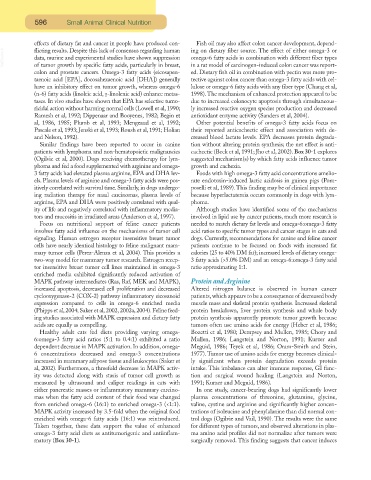Page 575 - Small Animal Clinical Nutrition 5th Edition
P. 575
596 Small Animal Clinical Nutrition
effects of dietary fat and cancer in people have produced con- Fish oil may also affect colon cancer development, depend-
VetBooks.ir flicting results. Despite this lack of consensus regarding human ing on dietary fiber source. The effect of either omega-3 or
omega-6 fatty acids in combination with different fiber types
data, murine and experimental studies have shown suppression
in a rat model of carcinogen-induced colon cancer was report-
of tumor growth by specific fatty acids, particularly in breast,
colon and prostate cancers. Omega-3 fatty acids (eicosapen- ed. Dietary fish oil in combination with pectin was more pro-
taenoic acid [EPA], docosahexaenoic acid [DHA]) generally tective against colon cancer than omega-3 fatty acids with cel-
have an inhibitory effect on tumor growth, whereas omega-6 lulose or omega-6 fatty acids with any fiber type (Chang et al,
(n-6) fatty acids (linoleic acid, γ-linolenic acid) enhance metas- 1998).The mechanism of enhanced protection appeared to be
tases. In vivo studies have shown that EPA has selective tumo- due to increased colonocyte apoptosis through simultaneous-
ricidal action without harming normal cells (Lowell et al, 1990; ly increased reactive oxygen species production and decreased
Ramesh et al, 1992; Dippenaar and Booyenes, 1982; Begin et antioxidant enzyme activity (Sanders et al, 2004).
al, 1986, 1985; Plumb et al, 1993; Mengeaud et al, 1992; Other potential benefits of omega-3 fatty acids focus on
Pascale et al, 1993; Jenski et al, 1993; Roush et al, 1991; Holian their reported anticachectic effect and association with de-
and Nelson, 1992). creased blood lactate levels. EPA decreases protein degrada-
Similar findings have been reported to occur in canine tion without altering protein synthesis; the net effect is anti-
patients with lymphoma and non-hematopoietic malignancies cachectic (Beck et al, 1991; Jho et al, 2002). Box 30-1 explores
(Ogilvie et al, 2000). Dogs receiving chemotherapy for lym- suggested mechanism(s) by which fatty acids influence tumor
phoma and fed a food supplemented with arginine and omega- growth and cachexia.
3 fatty acids had elevated plasma arginine, EPA and DHA lev- Foods with high omega-3 fatty acid concentrations amelio-
els. Plasma levels of arginine and omega-3 fatty acids were pos- rate endotoxin-induced lactic acidosis in guinea pigs (Pom-
itively correlated with survival time. Similarly, in dogs undergo- poselli et al, 1989).This finding may be of clinical importance
ing radiation therapy for nasal carcinomas, plasma levels of because hyperlactatemia occurs commonly in dogs with lym-
arginine, EPA and DHA were positively correlated with qual- phoma.
ity of life and negatively correlated with inflammatory media- Although studies have identified some of the mechanisms
tors and mucositis in irradiated areas (Anderson et al, 1997). involved in lipid use by cancer patients, much more research is
Focus on nutritional support of feline cancer patients needed to match dietary fat levels and omega-6:omega-3 fatty
involves fatty acid influence on the mechanisms of tumor cell acid ratios to specific tumor types and cancer stages in cats and
signaling. Human estrogen receptor insensitive breast tumor dogs. Currently, recommendations for canine and feline cancer
cells have nearly identical histology to feline malignant mam- patients continue to be focused on foods with increased fat
mary tumor cells (Perez-Alenza et al, 2004). This provides a calories (25 to 40% DM fat); increased levels of dietary omega-
two-way model for mammary tumor research. Estrogen recep- 3 fatty acids (>5.0% DM) and an omega-6:omega-3 fatty acid
tor insensitive breast tumor cell lines maintained in omega-3 ratio approximating 1:1.
enriched media exhibited significantly reduced activation of
MAPK pathway intermediates (Ras, Raf, MEK and MAPK), Protein and Arginine
increased apoptosis, decreased cell proliferation and decreased Altered nitrogen balance is observed in human cancer
cyclooxygenase-2 (COX-2) pathway inflammatory eicosanoid patients, which appears to be a consequence of decreased body
expression compared to cells in omega-6 enriched media muscle mass and skeletal protein synthesis. Increased skeletal
(Phipps et al, 2004; Saker et al, 2002, 2002a, 2004). Feline feed- protein breakdown, liver protein synthesis and whole body
ing studies associated with MAPK expression and dietary fatty protein synthesis apparently promote tumor growth because
acids are equally as compelling. tumors often use amino acids for energy (Heber et al, 1986;
Healthy adult cats fed diets providing varying omega- Bozetti et al, 1980; Dempsey and Mullen, 1985; Chory and
6:omega-3 fatty acid ratios (5:1 to 0.4:1) exhibited a ratio Mullen, 1986; Langstein and Norton, 1991; Kurzer and
dependent decrease in MAPK activation. In addition, omega- Meguid, 1986; Teyek et al, 1986; Oram-Smith and Stein,
6 concentrations decreased and omega-3 concentrations 1977). Tumor use of amino acids for energy becomes clinical-
increased in mammary adipose tissue and leukocytes (Saker et ly significant when protein degradation exceeds protein
al, 2002). Furthermore, a threefold decrease in MAPK activ- intake. This imbalance can alter immune response, GI func-
ity was detected along with stasis of tumor cell growth as tion and surgical wound healing (Langstein and Norton,
measured by ultrasound and caliper readings in cats with 1991; Kurzer and Meguid, 1986).
either pancreatic masses or inflammatory mammary carcino- In one study, cancer-bearing dogs had significantly lower
mas when the fatty acid content of their food was changed plasma concentrations of threonine, glutamine, glycine,
from enriched omega-6 (16:1) to enriched omega-3 (<1:1). valine, cystine and arginine and significantly higher concen-
MAPK activity increased by 3.5-fold when the original food trations of isoleucine and phenylalanine than did normal con-
enriched with omega-6 fatty acids (16:1) was reintroduced. trol dogs (Ogilvie and Vail, 1990). The results were the same
Taken together, these data support the value of enhanced for different types of tumors, and observed alterations in plas-
omega-3 fatty acid diets as antitumorigenic and antiinflam- ma amino acid profiles did not normalize after tumors were
matory (Box 30-1). surgically removed. This finding suggests that cancer induces

